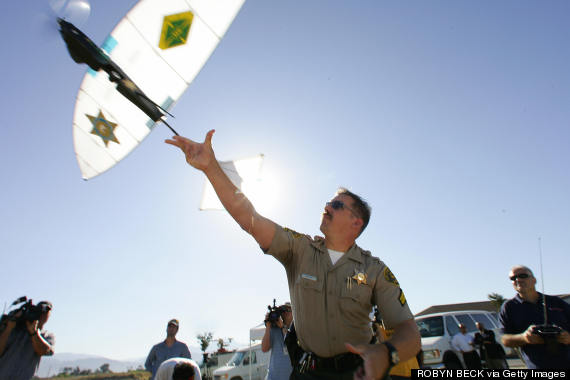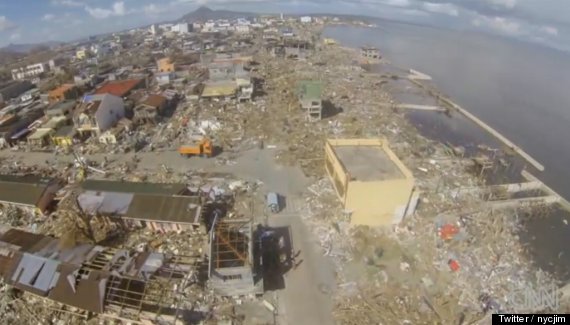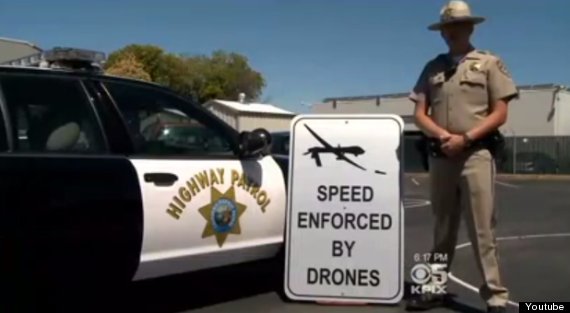Imagine a future chock full of unmanned vehicles, more commonly referred to by the ominous, near-Star Warsian term "drones." Did your brain just go to a scary place, where missiles and James Bond lasers are raining down on us all? Well, you're certainly not alone.
But what about the awesome side of the future? With jetpacks and whole meals in a single pill and robots that rub your feet after a long day of jetpacking! Drones can be part of that future, too, and they almost certainly will be -- which of course won't make them any less terrifying.
Despite the fear they often rightfully elicit, here are nine reasons why drones are actually awesome (as well as a few why they aren't):
1. Drones Can Map The World In Stunning Detail
Drones not only allow versatility in mapping terrain, they also allow us to get highly detailed renders of the environment that we can't get from satellites. This year, the people at the UAV team SenseFly and the aerial photography company Pix4D launched three drones to navigate and scan the Matterhorn, one of the tallest peaks in the Swiss Alps. The drones did so in just six hours, creating a stunningly detailed 3D model of the iconic mountain, made up of 300 million mapping points.
Think of it. In the future, drones could map out the entire Earth with extreme detail, then allowing us to play "Earth: The Video Game" on our Playstation 20s.
2. Drones Work Tirelessly To Help Save Lives...
In a poll about drone use, a whopping 83 percent of respondents said they approved of using the devices for search and rescue operations.
Understandably, using drones for search and rescue isn't very controversial, and in fact we've been using robots in such scenarios for years. Perhaps not airborne robots, but roboticists have developed many robots built to navigate rubble or tightly enclosed spaces. From amoeba-inspired robots to Japan's small army of earthquake response droids, the land drone has been around, or at least in development, for years now.
In the U.S., the first real test for modern rescue drones occurred after the terrorist attacks on September 11, 2001. Robots could venture deep into the rubble, farther than dogs or humans were able to.

A Los Angeles Sheriff launches a drone used for surveillance and rescue operations.
3. And To Treat People In Remote Areas...
This is another emerging area where drones could pay huge dividends. Enter: The Matternet. The Matternet was an idea conceived in 2011 by a group of students at Singularity University. The idea behind the project is a net delivery system of UAVs that are able to transport not just medicine, but anything that might be needed by people who live in places that are not accessible by road. The group has already performed a few test runs, including one in Haiti, and so far their prototypes can carry one to two kilograms and have a range of 10 kilometers.
...But Drones Are Also "Awesomely" Efficient At Taking Lives
And far, far, far too often, they're the wrong ones.
It shouldn't come as any surprise that drones have commanded attention primarily because of their gruesome military applications. As with most advances in technology, the first thing humans try to figure out is how they can use them to kill other humans. Drones, which have been used by the U.S. military in various forms for the past 50 years, are no exception to this rule.
Americans have increasingly expressed skepticism about the usefulness of drones to systematically target supposed terrorist targets in foreign nations, especially when those strikes may lead to collateral damage or civilian deaths. The foreign nations whose soil is often soaked in the blood of these victims have also pushed back against the practice, arguing that the U.S. is further destroying its global standing and creating recruitment tools for extremists. But defenders of drones strikes have maintained that they are necessary to keep fighting the war on terror, serving as less costly alternatives, both in terms of lives and money, to putting boots on the ground.
4. Drones Will Finally Allow Us To Stop Climbing Trees, After Millions Of Years
Small tress are still fair game, but Helene Muller-Landau, an ecologist with the Smithsonian Tropical Research Institute, says drones could give scientists quicker and easier access to massive new troves of data. For example, ecologists can survey forests much more thoroughly, gathering information about the tree tops and forest canopies that were before only reachable by humans willing to scale the trees. This would be preferred to imagery from a satellite, or from a costly flyover by a traditional aircraft that would lack the pinpoint resolution, or wouldn't allow for frequent data collection.
5. Animals Are The Drone's Friends -- Don't Mess With The Animals
Poaching is a massive global industry and conservationists have been struggling to keep up with evolving poacher methods. Earlier this month, the western Black Rhinoceros was officially labeled extinct after heavy poaching. In central Africa, poachers are responsible for the elephant population dropping nearly two-thirds in the past ten years.
Conservationists are already using drones to stop poachers in Kenya’s Maasai Mara National Reserve, needing no more than a $300 two foot long drone and an iPad. And conservationists will need those cheap operating costs if they hope to combat the lucrative practice of poaching. Poachers can make $1000 per kilogram on ivory, and rhino horns can fetch a price comparable to gold in China, where they're mistakenly believed to cure cancer and boost sexual prowess.
The business world and robotics companies are behind these conservation initiatives. Google donated $5 million towards the World Wildlife Fund's drone program to prevent poaching. The WWF has had great success protecting rhinos with drones in Nepal. Prior to their presence, a rhino was being killed once a month, and in two years since their arrival, only two endangered rhinos have been killed. With Google's donation, the WWF is ready to open their anti-poaching umbrella over Asia and Africa.
6. Drones Can Help Save Smaller Farms
Farms are still rapidly becoming super-sized, making it more difficult for smaller family operations to compete with the massive corporate-controlled behemoths. And as the farming dynamic of the past continues to disappear, so too has the ability to have a hands-on agricultural touch in the field.
But truth be told, there are actually more "small" farms than ever, even though the vast majority of America's crops are provided by large subsidized farms. And even the smaller farms are getting bigger, meaning that their crop fields are getting too expansive for human beings to walk and diagnose their yields on a localized basis.
That's where drones come in. With the help of low cost, camera-armed UAVs, farms with small staffs but large acreage may soon be able to target specific locations on their land, increasing efficiency and inevitably decreasing maintenance costs. Chris Anderson, the CEO of 3D Robotics and former editor-in-chief of Wired, says drones could pinpoint areas for pesticide use, thereby avoiding overuse and limiting how much gets into the final food supply. Similarly, drones could identify areas with low chlorophyl levels by using infrared technology, allowing farmers to spot treat patches earlier than is possible to detect with the naked eye.
Utilizing drones in this way might allow medium-sized farms -- which are currently dwindling -- to compete at a lower cost, without needing to sell to or coordinate with corporate entities. Go, drones!
7. Drones May Someday Bring Justice To The Jerk Who Cut You Off
While this power hasn't been given to drones yet, last year the Federal Aviation Administration approved a number of government and non-government agencies to use the unmanned devices. Certain local law enforcement agencies were also given the green light, which raised some red flags with civil liberties groups, apprehensive citizens and even political artists.
The majority of Americans oppose the use of drones for issuing traffic tickets, according to a recent poll, but it's hard to believe that law enforcement agencies wouldn't want to use them to crack down on law-breaking drivers. Police officials have insisted they'd use drones only to monitor traffic and not to bust violators or track civilian cars, and they never abuse their power, right?
And if you look outside and see a drone following your speeding vehicle, don't panic just yet. The Atlantic reported in 2012 that the Air Force was training drone pilots by following civilian vehicles along a New Mexico highway.
8. Drones Can Allow Journalists To See The Whole Picture
With the spread of social media and the connectivity and access that comes with it, we're gradually entering a world where news operates on the fly, often without being fed through officials who may have an interest in how that information is packaged. Drones are increasingly becoming a part of that world. It's a very new field, and right now resides in a gray area of the legal system. Though President Barack Obama's administration has prompted the FAA to clear the way for domestic commercial drones, as of now they are still restricted in four states, with 39 states considering legislation.
During the Arab Spring, where Twitter helped get information off the ground in places like Egypt, Tunisia, Turkey and Syria when official sources could not be relied upon, drones literally helped give us a more complete picture. And just a few weeks ago, a drone captured the vast devastation left by typhoon Haiyan in the Philippines.

Drone surveying the incredible damage done by Haiyan.
9. Drones Will Allow Us To Have Pizza Surfing Pool Parties!
Drones don't have to be all about grownups with jobs and responsibilities -- they can be fun, too! A UK Domino's released a video earlier this year showing their "DomiCopter" flying around delivering pizzas. While this was just a concept project, it's not inconceivable that one day drones will show up with pizza at your door. Hopefully it won't be a prank.

But now it's the next day, and no one wants to eat drone pizza two days in a row, so just hit up the Tacocopter, a semi-autonomous taco delivery drone!
Pizza and tacos delivered by robots? Finally, a food delivery system that won't judge us when we show up to the door with no pants on.
Drones are also being used to film sporting events, especially sports where it's tough for cameramen to get close to the action. Surfing was traditionally shot like this...

With drones, it looks like this!

But if surfing and pizza aren't your thing, surely you enjoy a good pool party. And no pool party is complete without its very own drone. Isn't partying with robots what we all dreamed about growing up?

The DJI Phantom Quadcopter is just happy everyone's having a good time.
... But Thanks To Our Shady Government, We Have An Understandable Distrust Of Drones
A Gallup poll taken earlier this year showed that, outside of their use to hunt down terrorists in other countries (a point that gets significantly complicated when the collateral damage is taken into account), people have serious concerns about using drones in a non-military capacity, largely due to issues of privacy. One Colorado town has gone so far as to start encouraging residents to shoot down the unmanned vehicles with "drone hunting licenses." But why? It's not like the government has a long history of abusing people's privacy.
Oh wait, yes it does. And that's not even counting the recent NSA hullaballoo. Other agencies have in fact been compromising your privacy for years. The thing is, drones knowing your location at any particular moment shouldn't necessarily frighten you that much. Just to be clear, they can, as former FBI director Robert Mueller confirmed before Congress. But you should be used to it. You've been carrying a genuine tracking device for years, in your cellphone. And police and government officials have access to the massive amounts of data stored on your mobile device, so long as they have a warrant.

Remember, cell phones can kill.
Fairly or unfairly, drones have a negative reputation. But they are almost certainly here to stay, so while we continue to have a healthy distrust of the terrible ways they are being used, let's also remember that they're doing some pretty awesome things as well.






